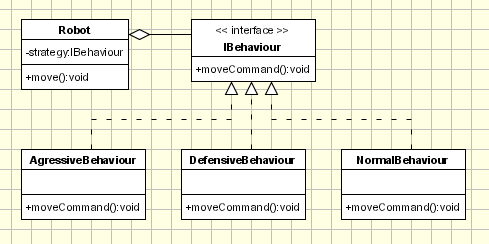Strategy Pattern: Robot Behavior Switching Example
In this example of the strategy pattern, each robot has a behavior: aggressive, defensive or neutral. Aggresive robots are running other
robots in their view, defensive robots are running from any other robots, while neutral are just moving forward. When the robots
collide their behavior changes. You can also click on robots to change their behavior.
Example - Robots Application
Let's consider an application used to simulate and study robots interaction. For the beginning a
simple application is created to simulate an arena where robots are interacting. We have the
following classes:
IBehaviour (Strategy) - an interface that defines the behavior of a robot
Concrete Strategies: AggressiveBehaviour, DefensiveBehaviour,
NormalBehaviour; each of them defines a specific behavior. In order to decide
the action this class needs information that is passed from robot sensors like position, close obstacles, etc.
Robot - The robot is the context class. It keeps or gets context information such as position, close obstacles
, etc, and passes necessary information to the Strategy class.
In the main section of the application the several robots are created and several different behaviors are
created. Each robot has a different behavior assigned: 'Big Robot' is an aggressive one and
attacks any other robot found, 'George v.2.1' is really scared and run away in the opposite
direction when it encounter another robot and 'R2' is pretty calm and ignore any other
robot. At some point the behaviors are changed for each robot.
public interface IBehaviour {
public int moveCommand();
}
public class AgressiveBehaviour implements IBehaviour{
public int moveCommand()
{
System.out.println("\tAgressive Behaviour: if find another robot attack it");
return 1;
}
}
public class DefensiveBehaviour implements IBehaviour{
public int moveCommand()
{
System.out.println("\tDefensive Behaviour: if find another robot run from it");
return -1;
}
}
public class NormalBehaviour implements IBehaviour{
public int moveCommand()
{
System.out.println("\tNormal Behaviour: if find another robot ignore it");
return 0;
}
}
public class Robot {
IBehaviour behaviour;
String name;
public Robot(String name)
{
this.name = name;
}
public void setBehaviour(IBehaviour behaviour)
{
this.behaviour = behaviour;
}
public IBehaviour getBehaviour()
{
return behaviour;
}
public void move()
{
System.out.println(this.name + ": Based on current position" +
"the behaviour object decide the next move:");
int command = behaviour.moveCommand();
// ... send the command to mechanisms
System.out.println("\tThe result returned by behaviour object " +
"is sent to the movement mechanisms " +
" for the robot '" + this.name + "'");
}
public String getName() {
return name;
}
public void setName(String name) {
this.name = name;
}
}
public class Main {
public static void main(String[] args) {
Robot r1 = new Robot("Big Robot");
Robot r2 = new Robot("George v.2.1");
Robot r3 = new Robot("R2");
r1.setBehaviour(new AgressiveBehaviour());
r2.setBehaviour(new DefensiveBehaviour());
r3.setBehaviour(new NormalBehaviour());
r1.move();
r2.move();
r3.move();
System.out.println("\r\nNew behaviours: " +
"\r\n\t'Big Robot' gets really scared" +
"\r\n\t, 'George v.2.1' becomes really mad because" +
"it's always attacked by other robots" +
"\r\n\t and R2 keeps its calm\r\n");
r1.setBehaviour(new DefensiveBehaviour());
r2.setBehaviour(new AgressiveBehaviour());
r1.move();
r2.move();
r3.move();
}
}

